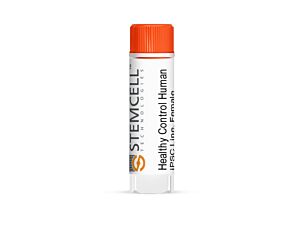STEMdiff™-ACF RPE Differentiation Kit
Animal component-free differentiation kit for the generation of immature retinal pigment epithelium from human pluripotent stem cells

Request Pricing
Thank you for your interest in this product. Please provide us with your contact information and your local representative will contact you with a customized quote. Where appropriate, they can also assist you with a(n):
Estimated delivery time for your area
Product sample or exclusive offer
In-lab demonstration
-
 STEMdiff™-ACF RPE Plating Supplement
STEMdiff™-ACF RPE Plating SupplementAnimal component-free supplement for improving survival and attachment of hPSC-derived retinal pigment epithelial cells
-
 STEMdiff™-XF RPE Maturation Medium
STEMdiff™-XF RPE Maturation MediumSerum-free and xeno-free medium for generating fully functional and mature hPSC-derived retinal pigment epithelium
-
Labeling Antibodies
Compatible antibodies for purity assessment of isolated cells
Overview
Immature RPE generated using STEMdiff™-ACF RPE Differentiation Kit can be cryopreserved as an intermediate cell bank or matured further into functional RPE using STEMdiff™-XF RPE Maturation Medium. By using these products together, a highly pure population of RPE (Figure 2) can be generated from hPSCs in as few as 49 days without the need for manual selection or cell enrichment. Increase the yields and survivability of your RPE cell differentiation and maturation by adding the STEMdiff™-ACF RPE Plating Supplement to this workflow.
Cells derived using these products can be used for modeling human retinal development and disease, drug screening, cell and gene therapy validation, and advanced tissue model development.
Please contact us if you intend to use this product for commercial or clinical applications.
Data Figures

Figure 1. Workflow for the Differentiation of hPSCs into Retinal Pigment Epithelium (RPE) with STEMdiff™ RPE Culture System
hPSC colonies, previously harvested and seeded as clumps, are put directly into the medium provided in STEMdiff™-ACF RPE Differentiation Kit. Seeding into STEMdiff™ RPE Differentiation Medium A induces cells toward immature RPE. A full medium change is performed on Day 1 with fresh STEMdiff™ RPE Differentiation Medium A and then on Day 2 with STEMdiff™ RPE Differentiation Medium B. On Days 4 and 6, medium changes are performed with fresh STEMdiff™ RPE Differentiation Medium C. On Days 7 and every second day thereafter a medium change is performed with fresh STEMdiff™ RPE Differentiation Medium D. On Day 14, immature RPE cells are enzymatically harvested and subcultured in STEMdiff™-XF RPE Maturation Medium with the addition of STEMdiff™-ACF RPE Plating Supplement from Days 14 to 21 to improve survival after passaging. RPE cells begin to mature over the course of 5 weeks of culture in STEMdiff™-XF RPE Maturation Medium and become fully matured by Day 49, possessing key characteristics such as polygonal shape, polarization, pigmentation and phagocytosis.

Figure 2. Robust and Rapid Generation of Mature Retinal Pigment Epithelial Cells (RPE) across multiple PSC Cell Lines with the STEMdiff™-ACF RPE Differentiation Kit
hPSCs were cultured for 14 Days using STEMdiff™-ACF RPE Differentiation Kit and subsequently subcultured in STEMdiff™-XF RPE Maturation Medium. Flow cytometry expression of RPE markers are shown at Day 14 and Day 49. (A) The percentage of cells expressing PMEL17, RPE65, EZRIN, and CRALBP and (B) Viable cell yields for 4 hPSC cell lines. PMEL17 is expressed at Day 14 and 49 while the other markers are only present at Day 49. Data are reported as mean + SEM; n = 16 -20. (C) A cell pellet of mature RPE cells demonstrates the pigmentation. Maturation is further demonstrated with immunohistochemistry for expression of RPE markers at Day 49. (D, E, F, G) Mature RPE display tight junctions marked by localization of ZO1 and BEST1 to cell junctions. Mature RPE are polarized, expressing EZRIN apically and ZO1 subapically and express proteins required for the visual cycle (RPE65).

Figure 3. Mature Retinal Pigment Epithelial (RPE) Cells Display Key Functionalities Corresponding to RPE Behaviour
hPSC’s were cultured for 14 Days using STEMdiff™-ACF RPE Differentiation Kit and subsequently subcultured on cell culture inserts in STEMdiff™-XF RPE Maturation Medium for 5 weeks. Apical and basal conditioned medium were collected from Mature RPE, and a sandwich ELISA was performed to quantify Vascular Endothelial Growth Factor (VEGF) and Pigment Epithelial Derived Growth Factor (PEDF) secretion. (A, B) Mature RPE secreted more basal VEGF and apical PEDF demonstrating RPE display correct apicobasal polarity. Data shown as mean + SEM; n = 3. (C) Mature RPE were able to generate a strong barrier with high transepithelial resistance (TER). Data shown as mean + SEM; n = 3-6. (D) Mature RPE were fed FITC-labelled bovine photoreceptor outer segments (POS) for 4 to 5 hours prior to being enzymatically dissociated for flow cytometry analysis or fixed with paraformaldehyde for immunostaining. (E) Mature RPE efficiently internalize bovine POS. Data shown as mean + SEM; n = 3. (F) A cross-sectional schematic of the cell insert culture system.
Protocols and Documentation
Find supporting information and directions for use in the Product Information Sheet or explore additional protocols below.
Applications
This product is designed for use in the following research area(s) as part of the highlighted workflow stage(s). Explore these workflows to learn more about the other products we offer to support each research area.
Related Products
-
 CryoStor® CS10
CryoStor® CS10Animal component-free, defined cryopreservation medium with 10% DMSO
-
 mTeSR™ Plus
mTeSR™ PluscGMP, stabilized feeder-free maintenance medium for human ES and iPS cells
-
 Healthy Control Human iPSC Line, Female, SCTi...
Healthy Control Human iPSC Line, Female, SCTi...Human pluripotent stem cell line, frozen
-
 Healthy Control Human iPSC Line, Male, SCTi00...
Healthy Control Human iPSC Line, Male, SCTi00...Human pluripotent stem cell line, frozen
Item added to your cart

STEMdiff™-ACF RPE Differentiation Kit
PRODUCTS ARE FOR RESEARCH USE ONLY AND NOT INTENDED FOR HUMAN OR ANIMAL DIAGNOSTIC OR THERAPEUTIC USES UNLESS OTHERWISE STATED. FOR ADDITIONAL INFORMATION ON QUALITY AT STEMCELL, REFER TO WWW.STEMCELL.COM/COMPLIANCE.
